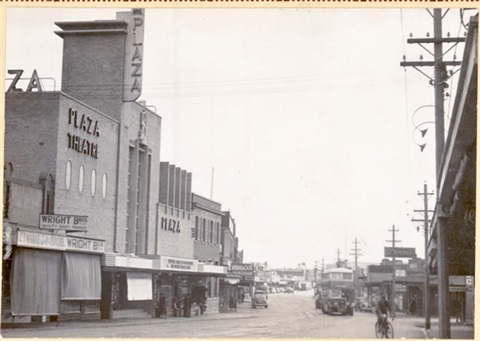Plaza Theatre

403 High Street Northcote
The design of The Plaza Theatre was modelled on the streamline Art Deco style of the Depression era. It was hailed as a sign of improving economic times when it opened in 1934 at number 403 High Street in the heart of Northcote’s shopping strip. The building utilised the old Northcote Market site remodelling it into a modern functional cinema. It was the height of the Hollywood movie craze with talkies revitalising an industry that like every other, was hit hard by the Great Depression. Many of the large lavish theatres were still under construction when the U.S. stock market crashed in 1929 and they subsequently went broke even before opening but people needed entertainment to distract them from economic hard times and the more modest suburban cinemas survived.
High Street was well supplied with theatres during the heyday of cinema in the 1930-1950s. The Northcote Theatre on Rucker’s Hill was one of the earliest venues to be built. It opened in 1912 and was often used for community functions such as the annual Mayoral Ball. The Westgarth Theatre opened at the bottom of the hill in 1921. The Rio and Regent Theatres in Thornbury followed in 1921 and 1926 respectively but the Rio survived only four years. Further up in Preston were The Planet, The Gowerville, The Circle, St James and The Rivoli.
The Plaza Theatre was commissioned by stage and managing director Mr Ludbrok Owen Menck (former owner of Melbourne Cup winner Colonus). It had seating capacity for 1,100 people and was listed in The Argus as operating under the independent theatre network. Primarily The Plaza showed MGM, Paramount and British films but it struggled to survive the 1930s despite the professional efforts of highly experienced manager Fred Cobley and Chief Projectionist Percy Spencer.
In 1941 the film producer turned theatre manager A. R. (Dick) Harwood reopened the theatre as a cabaret/vaudeville venue putting on live variety shows to complement the films and see the theatre through the war years and the 1940s. Film showing was eventually suspended in November 1949 but The Plaza was remodelled backstage and the seating capacity increased to 1,375 to continue as a variety venue until the films were reinstated in October 1953. It operated in this two-and-fro manner for many years closing again briefly in February 1959 and reopening almost a year later in April 1960 as an Italian film cinema.
In 1986 The Plaza became The Elysee Reception Centre with rumours that building alterations including the internal design and refit, were done by a ‘prominent Melbourne gambler’ without the knowledge or permission of the Northcote Council. In recent years it has suffered much neglect and has been offered for sale. Designs were drawn up recently to refurbish the building as urban apartments with ground level shops.
Australian veteran entertainer Toni “Lolly-legs” Lamond received early training and got her first break as a soubrette at the Plaza Theatre in 1940s. A soubrette was the performing equivalent of a ‘gopher’ doing everything from singing and dancing to assisting the juggler and magician on stage.
Andrew Distin Varley was a local Collingwood and Northcote man employed in the mechanical trade of last making and machinist. Throughout his life he was involved in vaudeville and part of the Plaza Theatre family.
Films shown at The Plaza Theatre were not top billing blockbusters but more modest stock films starring well-known actors. Stock films were an actor’s bread and butter and many top stars were locked into studio contracts making B-grade movies.
Some of these shown at theatres around Melbourne including The Plaza were:
McFadden’s Flat in September 1935.
“Two for Tonight” starring Bing Crosby and Joan Bennett and “Bar 20 Rides Again” starring William Boyd in August 1936.
“The Moon’s Our Home” starring Margaret Sullivan and Henry Fonda and “The Sky Parade” starring Jimmy Allen in November 1936.
“Poppy” starring W.C. Fields and Rochelle Hudson in December 1936.
“Big Brown Eyes” starring Cary Grant and Joan Bennett and “Border Flight” starring John Howard in February 1937.
Variety Revues performed at the Plaza Theatre over the years include:
“The Argus Appeal” – with performances by Sid Palmer and his 14-piece orchestra, Keith Rosenthal of the Tivoli Theatre, soprano Eileen Sheridan, tenor Mervyn Clark and the Rhythm Boys, the Cavalier Chorus and the Irish Four. In February 1939.
“Mother’s Day” performance for mother’s only in May 1940.
“Fun and Games” – for the re-launch in December 1949 of the Northcote Plaza as a variety venue with Al mack and Len Rich performing comedy to the music of Horrie Dargie and his band. A European acrobat troop The Leotards, trick cyclists the Halroy Brothers, Bruce Harvey and his rhythmical spoons, June Marlowe and the Plaza Ballet were also on the bill.
“Eyes Right” – with comedians Al Mack and Joff Ellen in February 1950.
“Laughter Express” – comprising a company of 35 with headline act comedian Buster Fiddes and an illusionist chosen by the Australian Magician’s Convention in October 1952.
“Cinderella Pantomime” – with Victorian Teenage Quest entrant Marion Williams as Cinderella, Val Jellay as Prince Charming, Hal Lennon and Stan Craig as the Ugly Sisters and Len Rich as the Baron in January 1952.
“Variety Cavalcade” in November 1952.
A Flood Appeal Show in March 1955.
Cinema survey.
Lemon, Andrew. (1983). The Northcote Side of the River. North Melbourne: Hargreen.
SUBURBAN VARIETY THEATRE OPENS. (1949, December 5). The Argus, (Melbourne, Vic : 1848-1956), p.18.
PLAZA THEATRE IS CLOSED AGAIN: JUST HOW BIG IS THIS “HOODOO”?. 1959, April), p.1. (The Northcote Leader)
WHAT MAKES THE MODERN THEATRE GO! (1939, September, 7). The Northcote Leader.
http://www.walkingmelbourne.com/forum/viewtopic.php?t=6317
http://caarp.flinders.edu.au/venue/260/view
http://www.abc.net.au/talkingheads/txt/s1482097.htm